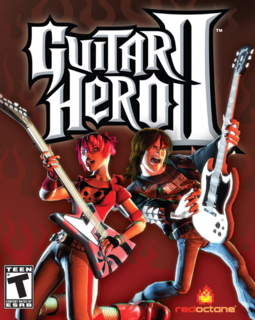Guitar Hero's Sidekick
For everyone else, this is a review about Guitar Hero II, a follow up to one of the most inventive and fun games of 2005.
Guitar Hero II is, at its core, just like any other rhythm game: you press buttons in time with visuals cues that are in sync with the music in the game, and you take care of the song’s guitar riffs.
The key difference, though, is how Guitar Hero is played. You’re given a small, plastic SG guitar with five colored fret buttons and a ‘strum bar’ to rock out on and, despite how dorky you look playing on it, it’s fantastic.
Unfortunately, though, it took a long time for this sequel to win me over. Now, now— put your pitchforks down you crazy original Guitar Hero fans. At least let me tell the story before you get all messy with my entrails.
Guitar Hero II is still good— but just like with any other sequel, the impact is gone. This game is more or less exactly what you played last year (which is a good thing) except with some new songs. This, however, is where things start to get a little sketchy. In a rhythm game, the songs pretty much make or break the whole experience.
It’s not that Guitar Hero II is missing good, playable tracks; it’s just that it has almost none of the musical variety that its predecessor was able to show off. Gone is the fancy fretwork of Ziggy Stardust and More Than A Feeling. What we have now is almost purely a selection of ‘how-fast-can-you-strum-and-still-stay-in-time?’ songs like Thin Lizzy’s Bad Reputation and Wolfmother’s Woman. There are even a few tracks that are just no fun to play and seem only to be included as ‘must-haves’ for the popularity of the band (I’m looking at you, Heart-Shaped Box).
This said, there is still a solid chunk of really fun songs, but not nearly enough of the expanded 64 track set list are homeruns that you’ll want to come back to time and time again. A lot of the indie tracks that are included are incredibly forgettable, save for Trogdor (No, I’m not kidding you, Strong Bad sings and everything), just because it’s no-name treatment of the same chugging metal style.
I also don’t want this to come off as me whining about the music being heavier. Honestly, I couldn’t care much less. It’s a guitar game and busting out heavy chords is part of what makes it so fun. It’s just that if that’s all you’ve got, it gets boring quick. All of the songs and artists look great on paper: you’ve got Foo Fighters, Dick Dale, Black Sabbath, Megadeth and many more, but not many of their chosen songs translate well into an engaging Guitar Hero experience.
Then there’s the flashy new co-operative mode that Guitar Hero II touts. To be fair, the multi-player isn’t only co-operative, but the new mode really comes across as the only one that matters, because it’s really the only game expanding addition that the title can play up. However, I still don’t feel like RedOctane hit the nail on the head here, either. The co-operative is really fun— if you’re playing lead guitar. This is true because the lead guitar gets, note-for-note, all the songs from single player. Rhythm and bass guitar, the less than stellar alternatives to lead, are treated only to repetitive background bits of any given song. Admittedly, these parts do still shovel out a fair portion of challenge, but I don’t want to just be tested on how accurately I can play the same bar over and over while my friend beside me gets a wicked-bad solo all to himself.
Face-off makes its obligatory return and when put side-by-side with co-operative (an argument waiting to happen over who gets to play lead fiddle), it’s a lot more enjoyable than its counter-part. Face-off comes in two flavors this time around: regular and pro. The difference between the two isn’t much, pro mode simply has both players play the entirety of a song rather than dueling in an answer/call manner, but you’ll develop a significant preference for one or the other right away. If you’re just tooling around and playing a “just for fun” competitive game of Guitar Hero II you’ll want regular mode, because it allows each player to adjust their individual difficulty level so that it is more in accordance with their Guitar Hero prowess. Pro, on the other hand, is for anyone who’s playing for keeps and would kill for bragging rights, as it puts players on an even battle field by giving them the exact same challenge: an unadulterated track from single player.
The saving grace of Guitar Hero II is that the songs that work well work better than anything from the previous game. The Stones’ Can’t You Hear Me Knockin’ and Primus’ John The Fisherman are both joys to play because RedOctance did such a good job of cleaning up the use of their guitar controller. Hammer-ons and pull-offs are far more responsive than they ever were in the first game and this makes learning how to get through those insane solos that much more compelling. You’ll be pulled in by that nagging “I’ve almost got it, one more try” feeling.
If you’re just one of those hardcore Guitar Hero fans who stood alone in their basement rocking the hell out of your mini-SG, then you won’t be bothered by any of the bad stuff above and you’ll love Guitar Hero II all the same. If, on the other hand, you really only busted out your Guitar Hero when your buddies were by and played it as a party thing, save yourself the sixty bucks and let one of your friends pick it up and bring it over sometime.

